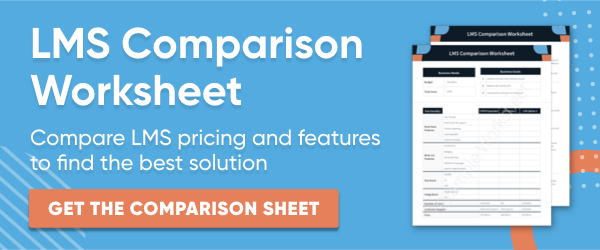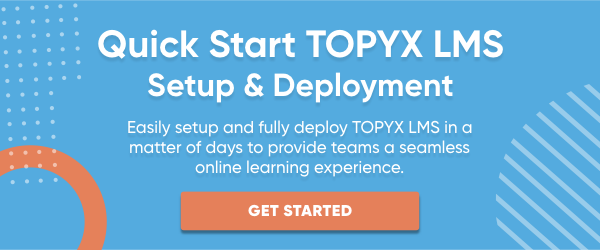Sixty-nine percent of workers are more apt to stick with a company for three years if they are properly onboarded, and companies that provide onboarding see a 50 percent improvement in productivity among new hires.1 Learning paths found within a learning management system (LMS) provide ideal functionality for a business to deliver effective onboarding programs, in addition to personalized, role-based training. By developing a set of LMS learning path best practices, L&D teams can enhance training programs to increase employee retention and productivity.
Related reading: What is a Learning Path? The Benefits of eLearning in Corporate Training.
LMS learning path best practice #1: Choose the right LMS
The quality of learning paths you provide to your employees depends on the learning management system you choose to deliver training with. Most LMS platforms have a built-in learning paths feature, but that doesn’t mean the feature is user-friendly. Ensure the tool is user-friendly for both the L&D teams who are responsible for organizing and uploading content to learning paths, as well as for employees engaging in onboarding and role-based training.
Take an LMS vendor’s learning path feature for a test drive by requesting an LMS demo. Demoing is a vital step in LMS selection because it helps you determine whether or not you are satisfied with how a learning path functions before implementing a new eLearning platform.
LMS learning path best practice #2: Cross-link learning path resources
Learning path users should be able to find the resources they need quickly. Otherwise, they may disengage from training. A contributor to TrainingIndustry.com made the point that cross-linking learning path resources could prevent learner fatigue and promote a better learning experience.
“(Cross-linking learning path resources) is done by providing access to new content upon completion of a relevant resource. If students are learning through on-demand training in an LMS, direct them to similar help content in the company knowledge base at the end of a lesson. Collaborate with product support or documentation teams to insert links to extended learning opportunities in help content.”2
By cross-linking learning path resources, the L&D team can stir learners’ interest in specific topics and inspire them to dig deeper, learn more, and better retain the information presented to them in their learning path.
LMS learning path best practice #3: Connect learning path user groups
To make learning paths more effective, try connecting learning path user groups. Use LMS social learning tools to create online learning communities and forums for these user groups, where they can chat with one another and share resources related to what they are learning without having to leave the LMS at any time. Digitally connecting user groups (like new hires or individuals in training for a specific job role, such as Customer Service Representative) will not only maximize training but also provide some social interaction during this time of isolation. Many businesses have moved to remote training in response to the pandemic, and this makes social connection via LMS software more important than ever.
LMS learning path best practice #4: Make learning objectives clear to learning path users
All employees, new or seasoned, will benefit from training that makes learning objectives explicit from the get-go and reminds them of those objectives periodically. Since a good portion of your learning path users will be new hires, it is particularly important to state learning objectives from the first online learning course on their learning path.
It can be easy to overlook stating learning objectives, but this LMS learning path best practice makes sense when you consider all the tasks new hires and other employees have on their plates each day. Making learning objectives clear throughout learning paths will help users go into a session knowing exactly what the purpose of training is. This will also help them to recognize when they aren’t catching onto key concepts in training. In this case, they can communicate their concerns to an instructor or LMS administrator and quickly get back on track.
Is your LMS learning path feature easy to use?
LMS learning paths should be simple for L&D teams to create and manage and for users to navigate. If an LMS learning path feature doesn’t make it easy for administrators to create quizzes and assignments, grade, manage users and user groups, and report on learning path training, it’s time to consider a new learning management system like TOPYX. Request an LMS demo of TOPYX to learn more.
Sources:
[1] https://www.shrm.org/resourcesandtools/hr-topics/talent-acquisition/pages/dont-underestimate-the-importance-of-effective-onboarding.aspx
[2] https://trainingindustry.com/magazine/may-june-2017/how-to-create-learning-pathways-that-scale/







